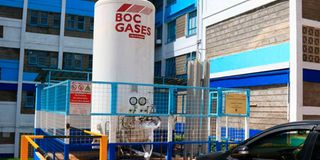Kenya ranked among top 15 African countries in healthcare access

What you need to know:
Kenya has shown marked improvement in access to affordable healthcare since 2010 .
This is according to the Mo Ibrahim Foundation’s report: Covid-19 in Africa: a Challenging Road to Recovery.
Kenya has shown marked improvement in access to affordable healthcare since 2010, with new data showing that the country ranks among the top 15 African nations.
The Mo Ibrahim Foundation’s report: Covid-19 in Africa: a Challenging Road to Recovery, indicates that Kenya ranks 14th in the indicator ‘Access to Healthcare’. However, many still have to pay out of pocket to access healthcare services.
Public healthcare in Kenya has customarily been financed by the government and donor agencies through grants and related funding, which has been associated with the inaccessibility to healthcare in the country. It is primarily extended through subsidies and insurance schemes.
Although the value of health care financing in Kenya has improved in the past five years from Sh41.7 billion in 2013/14 to Sh90 billion in 2018/19, a report by the United Nations SDG Partnership Platform and Aavishkaar-Intellecap Group cautioned that that is not enough given the country’s reliance on external partners for monetary support.
“In the recent past, Kenya has experienced positive economic growth and become a lower middle-income country; thus, the country is set to move progressively from external donor financing for health towards domestic funding.
“For this to happen, Kenya must now start planning for the challenge of replacing the current external partner investments with internal resources from national and county governments and the private sector,” the report said.
There is also the issue of accessibility, whereby hospitals are miles apart and patients lose lives while travelling to medical facilities. Data by the Kenya National Bureau of Statistics and the Kenya Institute for Public Policy Research and Analysis show that although there has been a remarkable expansion of healthcare infrastructure by counties, the number of facilities and workforce remain inadequate to cater for demand by a steadily rising population in need of such services
Only 12 per cent of health facilities had all items for standard precaution for infection prevention such as disposable syringes, disinfectant, safe final disposal of sharps, safe disposal of infectious waste, alcohol based sanitisers and appropriate storage of infectious waste.
The report shows that on average, health facilities had 55 per cent of basic amenities available, with only six per cent of the facilities having all basic amenities.
Efficient delivery of health services requires skilled personnel in adequate numbers. These include doctors, clinical officers, nurses, pharmacists, laboratory personnel, and specialists at different levels of care.
Other supportive staff cadres include the managerial staff, records officers, and cleaners. Understanding their numbers is therefore critical in planning for resource allocation, expansion of human resource capacity and identifying gaps, notes the report.





